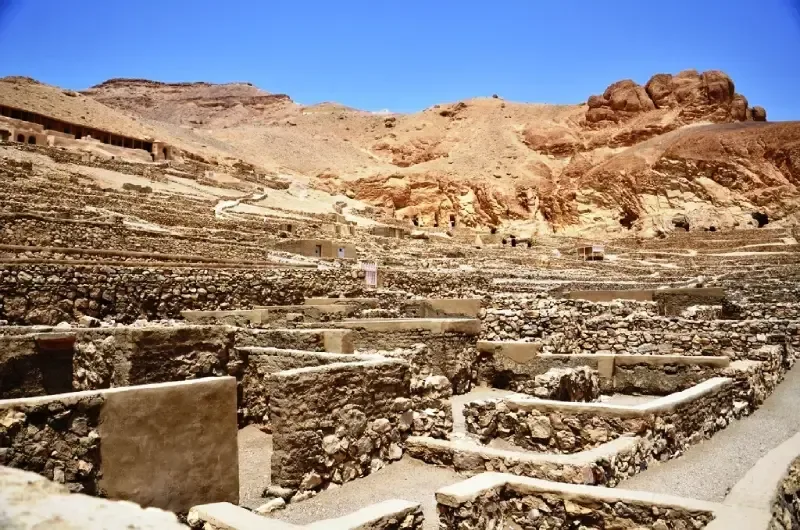The History of Deir el Medina
Deir el Medina is an ancient Egyptian workers' village near Thebes, where artisans and craftsmen lived and worked on the royal tombs in the nearby Valley of the Kings and the Valley of the Queens. Originally called Pa Demi ("the village"), it was known officially as Set-Ma'at ("The Place of Truth") due to the workers' role in creating eternal homes for kings and their families under divine inspiration. Founded by Amenhotep I to combat tomb robbery, this planned community operated from around 1541-1520 BCE until the collapse of the New Kingdom in 1069 BCE.
Origins and Purpose
The establishment of Deir el-Medina was a strategic response to the rampant tomb desecration that plagued the rulers of ancient Egypt. Amenhotep I, recognizing the need for greater security for royal burials, chose a remote location for the tombs, what is now the Valley of the Kings and the Valley of the Queens. Alongside this, he envisioned a dedicated community of artisans who would build and maintain these elaborate resting places discreetly.

The village's Arabic name, Deir el-Medina, derived from the later Coptic Christian occupation, reflects its evolution from a workers' settlement into a monastery. Yet, its ancient name, "Pa Demi" or "Place of Truth," alludes to the sacred trust the villagers upheld in safeguarding the sanctity of the tombs.
Excavations at Deir el-Medina have provided rich insights into daily life. The village, though small (1.4 acres), housed skilled workers and their families in tightly packed houses built within protective walls. These homes lacked self-sufficiency, relying on supplies from Thebes due to desert location.
Unveiling Daily Life
What sets Deir el-Medina apart is the remarkable wealth of information it provides about ordinary life during the New Kingdom period (c. 1570-1069 BCE). The meticulous excavation efforts, notably by Ernesto Schiaparelli and Bernard Bruyere, have unearthed a wealth of artifacts and insights into the villagers' daily routines, beliefs, and societal dynamics.
The community's layout, enclosed within protective walls, encompassed 68 houses and workshops arranged in a grid pattern over 1.4 acres. Interestingly, this was not a self-sufficient settlement. The artisans relied on regular shipments from Thebes for food, water, and other essentials, highlighting their specialized role within the larger society.
Architecture and Social Structure
A walk through the ruins of Deir el-Medina reveals a compact yet purposeful design. Houses, tightly packed and accessed through narrow alleyways, provided communal spaces for work, rest, and family life. The absence of designated bedrooms underscores the simplicity of their living arrangements.
In this predominantly male community, where artisans spent extended periods at the tombs—the women played a central role in household management and childcare. Intriguingly, the first room of each house often contained an enclosed space associated with childbirth, reflecting the villagers' reverence for fertility and domesticity.
Artistry Amidst Adversity
Unlike typical Egyptian villages, Deir el-Medina was not self-sufficient. Its residents predominantly male craftsmen relied on supplies brought from Thebes for sustenance. Daily life here revolved around artistic endeavors, with artisans creating exquisite artifacts for the afterlife and daily trade within the village. Ostraca fragments reveal a thriving economy fueled by craftsmanship.
Architecture and Social Structure
A walk through the ruins of Deir el-Medina reveals a compact yet purposeful design. Houses tightly packed and accessed through narrow alleyways provided communal spaces for work, rest, and family life. The absence of designated bedrooms underscores the simplicity of their living arrangements.
In this predominantly male community, where artisans spent extended periods at the tombs, the women played a central role in household management and childcare. Intriguingly, the first room of each house often contained an enclosed space associated with childbirth, reflecting the villagers' reverence for fertility and domesticity.
Challenges and Strife
Despite its idealized purpose, Deir el-Medina was not immune to human frailties. The villagers, isolated from broader society, experienced their share of interpersonal conflicts and moral lapses. Ostraca (inscribed pottery fragments) detail everyday transactions and disputes, from barter deals to allegations of adultery.
The community's decline mirrored broader shifts in Egypt's political landscape. Economic hardships, epitomized by the historic labor strike of c. 1156 BCE, foreshadowed the village's eventual abandonment. As centralized authority waned, some villagers turned to tomb robbery, signaling the unraveling of Amenhotep I's vision.
The Ebb of an Era
As the glory of the New Kingdom waned, so did the fortunes of Deir el-Medina. Late payments and the allure of tomb riches sowed seeds of discontent among the villagers. Tomb robbery, once unthinkable, infiltrated the community, signaling the end of an era. By c. 1069 BCE, the village was abandoned, its former residents seeking refuge in Thebes as the Valley of the Kings fell silent.
Legacy and Tourism
Today, Deir el-Medina is a living archaeological site, captivating modern visitors with its evocative remnants. Tourists exploring Luxor and Karnak Temple include this historic enclave in their itinerary, walking in the footsteps of long-gone artisans and imagining the vibrant community that once thrived here.
In essence, Deir el-Medina transcends its ancient origins, offering a poignant glimpse into the enduring human endeavor to preserve memory and honor in the face of time's relentless march. The artisans of this village, immortalized in their craft, remind us of the enduring bond between art, faith, and mortality—a bond that echoes through the ages from the Place of Truth in the heart of Egypt's desert.



